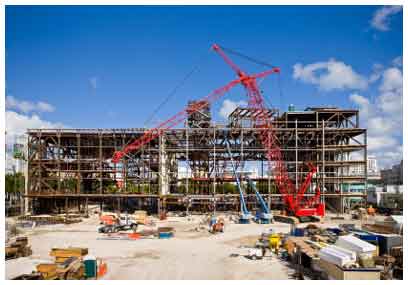September Employment, August Spending, Beige Book, AIA Reports are Positive Overall Editor’s note: Construction Citizen is proud to partner with AGC America to bring you AGC Chief Economist Ken Simonson's Data DIGest. Check back each week to get Ken's expert analysis of what's happening in our industry.
Editor’s note: Construction Citizen is proud to partner with AGC America to bring you AGC Chief Economist Ken Simonson's Data DIGest. Check back each week to get Ken's expert analysis of what's happening in our industry.
Nonfarm payroll employment increased by 148,000, seasonally adjusted, in September and 2,225,000 (1.7%) over 12 months, the Bureau of Labor Statistics (BLS) reported on Tuesday. Construction employment totaled 5,826,000, up 20,000 from August and up by 193,000 (3.4%) over the past year. Total hours worked in construction (aggregate weekly hours) increased by 4.2% since September 2012, implying that contractors are extending working hours slightly as well as hiring new workers. Residential construction employment (residential building and specialty trade contractors) climbed by 54,300 for the month and 103,300 (5.0%) for the year. Nonresidential employment (building, specialty trades, and heavy and civil engineering construction) rose by 14,500 and 90,000 (2.5%), respectively. The unemployment rate for jobseekers who last worked in construction tumbled to the lowest September level in six years—8.5%, down from 11.9% in September 2012 and 17.3% in September 2010. (Industry unemployment data are not seasonally adjusted and should only be compared year-over-year, not across months.) Since September 2010 the number of unemployed construction workers has dropped by 767,000, not seasonally adjusted. But construction employment rose by only 328,000, implying that many experienced workers have left the industry for employment elsewhere, further training or schooling, retirement or have left the workforce. These departures may make it hard for contractors to find skilled workers if demand picks up, even though the unemployment rate is currently higher than for the overall economy (7.0%, not seasonally adjusted) and wage growth and job openings do not yet signal any tightness nationally. Architectural and engineering services employment rose 2.0% over the year.
Construction spending in August reached a four-year high of $915 billion at a seasonally adjusted annual rate, up 0.6% from the July total (which was revised up $9 billion from the initial estimate) and up 7.1% from August 2012, the Census Bureau reported on Tuesday. Private residential spending increased 1.2% for the month and 19% year-over-year. Private nonresidential spending rose 0.1% and 4.3%, respectively. Public construction spending climbed 0.4% for the month but slipped 1.8% year-over-year. Of the three residential components, new single-family construction grew 1.6% and 28%; new multifamily spending, 3.2% and 38%; and improvements to existing single- and multifamily buildings, 0.2% and 5.5%. The three largest private nonresidential components (in descending order of current size) dipped in August but increased from 12 months ago: power construction (including conventional and renewable power plus oil and gas fields and pipelines), -0.1% and 9.8%, respectively; manufacturing construction, -0.1% and 5.6%; and commercial (new and renovated retail, warehouse and farm), -0.8% and 2.8%. The fastest-growing private nonresidential segment was lodging, up 1.5% and 28%. Of the top two public categories, highway and street construction inched up 0.1% for the month but slid 1.0% year-over-year, while educational fell 1.3% and 6.1%, respectively.
Informal soundings of businesses in the 12 Federal Reserve districts “suggest that national economic activity continued to expand at a modest to moderate pace during the reporting period of September through early October,” the Fed reported on Wednesday in the latest Beige Book, so named for the color of its cover. “Cleveland noted that low natural gas prices and regulatory uncertainty were slowing the build-out of shale-gas transport and processing infrastructure. In contrast, additional infrastructure projects to support natural resource extraction were mentioned in the Richmond, Minneapolis and Kansas City districts….Philadelphia and Minneapolis reported slight increases in activity at architecture firms....Demand for construction materials remained strong for Philadelphia, increased for Cleveland and San Francisco, was flat for Dallas and was slightly lower for the Chicago district….Residential construction increased moderately on balance, growing at a stronger pace in the Minneapolis and Dallas districts but only slightly in Richmond and Philadelphia. Multifamily construction remained stronger than single-family construction in a number of districts….Nonresidential construction activity remained modest, but varied by market and district. Growth was strong in the Minneapolis district, but up only slightly in Richmond, Atlanta and Philadelphia. The Cleveland, Chicago and St. Louis districts reported increased activity for industrial building, Cleveland noted strong demand from the healthcare sector, and redevelopment of vacant retail space picked up in Boston….several districts [noted] a pick-up in [commercial real estate lending.] The Chicago, Kansas City, Dallas and San Francisco districts reported upward pressure on prices for building materials such as asphalt, brick, lumber and concrete, with Kansas City indicating that concrete was in short supply in the Colorado areas affected by flooding….Most districts reported continued upward wage pressure for skilled workers, particularly those in…construction trades.”
The American Institute of Architects (AIA), as well as BLS and the Beige Book, reported gains for architects. More architecture firms reported rising than falling billings in September for the 13th time in 14 months, with net positive readings for all four practice types (residential, commercial/industrial, institutional and mixed), AIA stated on Wednesday.
The Data DIGest is a weekly summary of economic news; items most relevant to construction are in italics. All rights reserved. Sign up at www.agc.org/datadigest.
AGC's Data DIGest: October 17 – 24, 2013
by Ken Simonson | October 28, 2013



Add new comment